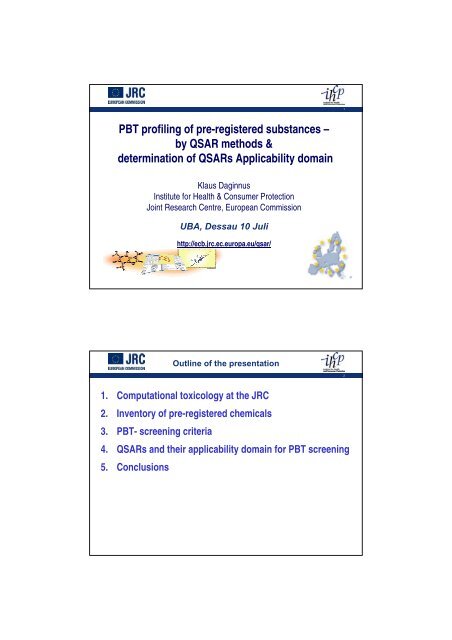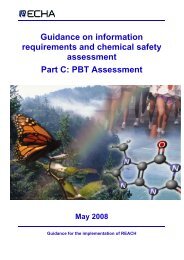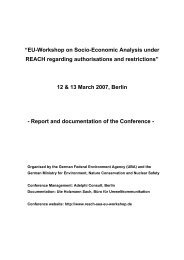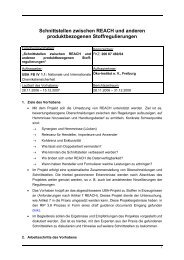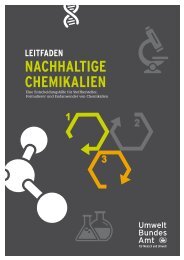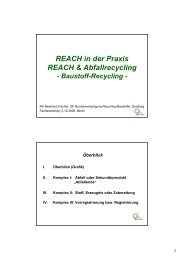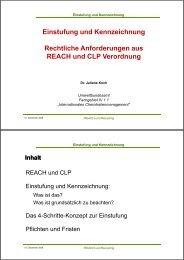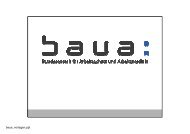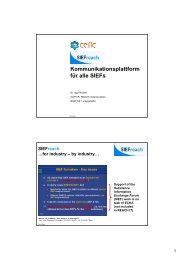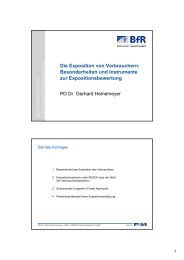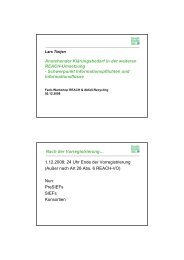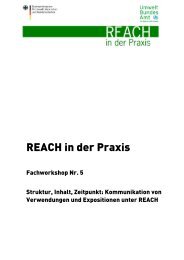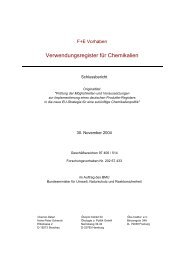PBT profiling of pre-registered substances – by QSAR ... - REACh
PBT profiling of pre-registered substances – by QSAR ... - REACh
PBT profiling of pre-registered substances – by QSAR ... - REACh
Create successful ePaper yourself
Turn your PDF publications into a flip-book with our unique Google optimized e-Paper software.
<strong>PBT</strong> <strong>pr<strong>of</strong>iling</strong> <strong>of</strong> <strong>pre</strong>-<strong>registered</strong> <strong>substances</strong> <strong>–</strong><br />
<strong>by</strong> <strong>QSAR</strong> methods &<br />
determination <strong>of</strong> <strong>QSAR</strong>s Applicability domain<br />
Klaus Daginnus<br />
Institute for Health & Consumer Protection<br />
Joint Research Centre, European Commission<br />
UBA, Dessau 10 Juli<br />
http://ecb.jrc.ec.europa.eu/qsar/<br />
1. Computational toxicology at the JRC<br />
2. Inventory <strong>of</strong> <strong>pre</strong>-<strong>registered</strong> chemicals<br />
3. <strong>PBT</strong>- screening criteria<br />
4. <strong>QSAR</strong>s and their applicability domain for <strong>PBT</strong> screening<br />
5. Conclusions<br />
Outline <strong>of</strong> the <strong>pre</strong>sentation<br />
1<br />
2
European Commission<br />
Directorates-General<br />
Directorates or Institutes<br />
Units<br />
Europeans Commissions<br />
Joint Research Centre<br />
Molecular Biology<br />
In Vitro Methods<br />
Nanobiosciences<br />
Chemical Assessment &<br />
Testing<br />
Systems Toxicology<br />
JRC<br />
Computational Toxicology<br />
Genetically Modified Organisms<br />
Alternative Methods & ECVAM<br />
Nanotechnology<br />
Policy<br />
Health and Environment Areas<br />
Consumer Products & Nutrition<br />
Overall aim: to promote the development, assessment, acceptance<br />
and implementation <strong>of</strong> computer-based methods potentially suitable<br />
for the regulatory assessment <strong>of</strong> chemicals<br />
Applications: REACH, Water Framework Directive, Cosmetics<br />
Directive, Biocides Directive, Plant Protection Products Directive<br />
Main approaches: SAR, <strong>QSAR</strong>, molecular modelling, ranking<br />
Computational methods provide information for use in hazard and<br />
risk assessment → “non-testing” or alternative methods<br />
http://ecb.jrc.ec.europa.eu/qsar/<br />
3<br />
4
A (Q)SAR should be associated with the following information:<br />
1. a defined endpoint<br />
2. an unambiguous algorithm<br />
<strong>QSAR</strong> Reporting Formats QMRF<br />
QMRF captures information on fulfilment <strong>of</strong> OECD validation principles,<br />
but no judgement or “validity statement” is included<br />
3. a defined applicability domain<br />
4. appropriate measures <strong>of</strong> goodness-<strong>of</strong>-fit, robustness and<br />
<strong>pre</strong>dictivity<br />
5. a mechanistic inter<strong>pre</strong>tation, if possible<br />
• Principles adopted <strong>by</strong> 37th Joint Meeting <strong>of</strong> Chemicals Committee and<br />
Working Party on Chemicals, Pesticides & Biotechnology; 17-19 Nov 2004<br />
• ECB <strong>pre</strong>liminary Guidance Document published in Nov 2005<br />
• OECD Guidance Document published in Feb 2007<br />
• OECD Guidance summarised in REACH guidance (IR and CSA)<br />
PRS <strong>–</strong> Inventory Production<br />
http://ecb.jrc.ec.europa.eu/qsar/information-sources/prs_inventory/<br />
5<br />
6
TSCA (CAS overlap)<br />
N, 1.4, 7%<br />
FootPrint<br />
DSSTOX<br />
2018<br />
2013<br />
2010<br />
records<br />
PRS Statistics<br />
PRS_Inventory & availability <strong>of</strong> experimental data<br />
1023<br />
1059<br />
6019<br />
6067<br />
8848<br />
Atommic properties "Mean" organic PRS-substance<br />
O, 2.9, 15%<br />
Cl, 0.2, 1%<br />
S, 0.3, 2%<br />
P, 0.0, 0%<br />
F, 0.3, 2%<br />
29551<br />
36533<br />
35011<br />
28492<br />
37692<br />
59599<br />
54698<br />
80413<br />
143835<br />
0 20000 40000 60000 80000 100000 120000 140000 160000<br />
Br, 0.1, 0%<br />
All Structure<br />
PRS parent <strong>substances</strong><br />
Atomic & Bond properties<br />
I, 0.0, 0%<br />
C, 14.6, 73%<br />
CanonicalTautomer<br />
UnknownStereoBonds<br />
StereoBonds<br />
is chiral<br />
N<br />
Stereochemistry PRS Parent_Substances<br />
6150<br />
11857<br />
13386<br />
15907<br />
62016<br />
0 10000 20000 30000 40000 50000 60000 70000<br />
7<br />
8
Assessment Persistency<br />
• Criteria: available half-life data collected<br />
under adequate conditions, criteria depend<br />
on environment, e.g.<br />
<strong>–</strong> P 40d in fresh water<br />
<strong>–</strong> vP 60d in fresh water<br />
• Screening P <strong>by</strong> EPISUITE<br />
<strong>–</strong> BIOWIN2 (does not biodegrade fast, probability < 0.5) +<br />
BIOWIN3 (ultimate biodegradation timescale <strong>pre</strong>diction < 2.2)<br />
or<br />
<strong>–</strong> BIOWIN6 (does not biodegrade fast, probability < 0.5) +<br />
BIOWIN3 (ultimate biodegradation timescale <strong>pre</strong>diction < 2.2)<br />
ECHA: Guidance on Information requirements and safety assessment, (R11) <strong>PBT</strong> assessment<br />
Assessment <strong>of</strong> Bio-accumulation<br />
• Criterion B: BCF > 2000 l/kg,<br />
• Criterion vB: BCF > 5000 l/kg<br />
• Screening Criterion not B/vB: <strong>by</strong> experiment<br />
or valid <strong>QSAR</strong> : log Kow
Toxicity Assessment<br />
• Criteria<br />
<strong>–</strong> NOEC < 0.01 mg/l<br />
<strong>–</strong> Substance classified as CMR<br />
<strong>–</strong> Other evidence <strong>of</strong> chronic toxicity<br />
• Screening criteria<br />
<strong>–</strong> Acute aquatic Toxicity < 0.1<br />
<strong>–</strong> Avian Toxicity < 30mg/kg food<br />
• Role <strong>of</strong> Non-testing data<br />
<strong>–</strong> “<strong>QSAR</strong> models seem not to be applicable for the definitive<br />
assessment <strong>of</strong> the T criteria”<br />
<strong>–</strong> at a screening level can be performed using data obtained from<br />
<strong>QSAR</strong>’s for acute aquatic toxicity<br />
P<br />
B<br />
T<br />
ECHA: Guidance on Information requirements and safety assessment, (R11) <strong>PBT</strong> assessment<br />
Applicability domain<br />
Applicability domain<br />
P EPISUITE Biowin N = 295<br />
B CAESAR N =466<br />
T DSSTOX N =585<br />
PRS-<br />
Inventory<br />
Organic Substances<br />
Merged<br />
N = 62.000 <strong>substances</strong><br />
11<br />
12
300<br />
250<br />
200<br />
150<br />
100<br />
30<br />
25<br />
20<br />
15<br />
10<br />
50<br />
5<br />
0<br />
0<br />
30<br />
25<br />
20<br />
15<br />
10<br />
7<br />
6<br />
5<br />
4<br />
3<br />
2<br />
1<br />
0<br />
5<br />
0<br />
243<br />
201<br />
19.1 14.2<br />
Atomic properties PRS inventory N=62016<br />
43<br />
Comparison <strong>of</strong> the chemicals space<br />
PRS & <strong>PBT</strong> datasets <strong>by</strong> atomic properties)<br />
18<br />
1.2 2.7 8<br />
0.0<br />
8<br />
0.3 0.6<br />
N_Atoms N_Carbon N_Ntrgen N_Oxygen N_Phsphr N_Sulfur N_Halogen<br />
26<br />
8.0<br />
Atomic properties Aquatic Toxicity dataset N=576<br />
4<br />
0.6<br />
7<br />
1.3<br />
70<br />
3<br />
1<br />
0.0 0.1 0.5<br />
N_Carbon N_Ntrgen N_Oxygen N_Phsphr N_Sulfur N_Halogen<br />
6<br />
Max<br />
Mean<br />
Max<br />
Mean<br />
45<br />
40<br />
35<br />
30<br />
25<br />
20<br />
15<br />
10<br />
5<br />
0<br />
40<br />
N_Atoms<br />
30<br />
25<br />
20<br />
15<br />
10<br />
5<br />
0<br />
13.5<br />
24<br />
33<br />
N_Carbon<br />
7.8<br />
10.2<br />
Atomic properties BCF dataset N=466<br />
6<br />
N_Ntrgen<br />
0.5<br />
10<br />
N_Oxygen<br />
1.3<br />
N_Phsphr<br />
3<br />
1 0.0 0.1<br />
N_Sulfur<br />
Atomic Properties Persistence dataset N=295<br />
6<br />
0.6<br />
10<br />
1.7<br />
4<br />
27<br />
N_Halogen<br />
1.4<br />
1<br />
0.0 0.1 0.5<br />
N_Carbon N_Ntrgen N_Oxygen N_Phsphr N_Sulfur N_Halogen<br />
Comparison <strong>of</strong> chemicals space<br />
PRS & <strong>PBT</strong> dataset <strong>by</strong> Fragment fingerprints<br />
Fragments Fingerprint PRS-Inverntory N=62016<br />
Fragments fingerprint BCF dataset N=466<br />
6<br />
5<br />
4<br />
3<br />
2<br />
1<br />
0<br />
4.5<br />
4<br />
3.5<br />
3<br />
2.5<br />
2<br />
1.5<br />
1<br />
0.5<br />
0<br />
Fragments fingerprint aquatic toxicity dataset N=576<br />
Fragments Fingerprint Persistence dataset N=295<br />
6<br />
13<br />
14<br />
Max<br />
Mean<br />
Max<br />
Mean
Merge BIOWIN in<br />
Applicability domain<br />
Merge BIOWIN<br />
BIOWIN 6 & BIOWIN 3<br />
BIOWIN 2 & BIOWIN 3<br />
records<br />
7296<br />
Screening Assignment P <strong>by</strong> BIOWIN<br />
15471<br />
15454<br />
13856<br />
61914<br />
0 10000 20000 30000 40000 50000 60000 70000<br />
BIOWIN<br />
Applicability<br />
domain?<br />
Fragments not<br />
re<strong>pre</strong>sented<br />
Remaining<br />
<strong>substances</strong><br />
EPISUITE 4.0 http://www.epa.gov/oppt/exposure/pubs/episuite.htm<br />
Generation <strong>of</strong> JRC <strong>QSAR</strong> models<br />
Bioaccumulation, Aquatic Toxicity<br />
S<strong>of</strong>tware ADMET ADMET modeler<br />
Method : Kernel Modeler partial<br />
least Methodsquares Kernel partial<br />
Descriptors, e.g. least square<br />
Desriptors Constitutional 2D, total111, 321there<strong>of</strong><br />
80<br />
Constitutional<br />
fragments<br />
111<br />
descriptors<br />
Topological<br />
total<br />
14<br />
Atom type E-state 65<br />
There<strong>of</strong> Electronic fragments properties 80 73<br />
Topological Hydrogen bonding 14descriptors<br />
Atom 14type<br />
E-state 65<br />
Molecular ionization 12<br />
Electronic<br />
properties<br />
73<br />
Hydrogen bonding<br />
descriptors<br />
14<br />
Molecular ionization 12<br />
BCF JRC model<br />
IDENTICAL AND LOW<br />
VARIANCE INPUTS:<br />
63 Identical<br />
39 inputs are underre<strong>pre</strong>sented<br />
(
Applicability domain BCF<br />
Applicability domain<br />
Fragments not re<strong>pre</strong>sented 7247<br />
Fragments underre<strong>pre</strong>sented<br />
13560<br />
Out <strong>of</strong> descriptors space 1924<br />
<strong>QSAR</strong> generated <strong>by</strong> Kernel partial least squares, 6 descriptors, ADMET modeler s<strong>of</strong>tware<br />
17<br />
Remaining <strong>substances</strong> 41393<br />
Screening Assignment B JRC model<br />
B in applicability domain<br />
B<br />
vB in applicability<br />
domain<br />
vB<br />
not B<br />
records<br />
875<br />
1065<br />
831<br />
949<br />
49054<br />
62016<br />
0 10000 20000 30000 40000 50000 60000 70000<br />
18
Applicability domain<br />
Aquatic Toxicity baseline toxicity<br />
not classified,<br />
45838, 74%<br />
PRS Verhaar classification<br />
baseline toxicity,<br />
3566, 6%<br />
less inert , 1536,<br />
2%<br />
unspefic reactivity,<br />
10995, 18%<br />
specific<br />
mechanism, 48, 0%<br />
<strong>QSAR</strong> generated <strong>by</strong> Kernel partial least squares, 2 descriptors, ADMET modeler s<strong>of</strong>tware<br />
Applicability domain<br />
Aquatic toxicity<br />
Applicability domain<br />
Fragments not re<strong>pre</strong>sented 8358<br />
Fragments underre<strong>pre</strong>sented<br />
19<br />
20<br />
15014<br />
Out <strong>of</strong> descriptors space 14213<br />
Remaining <strong>substances</strong> 33972<br />
<strong>QSAR</strong> generated <strong>by</strong> Kernel partial least squares, 15 descriptors, ADMET modeler s<strong>of</strong>tware
Merge in Applicability<br />
domain<br />
Merge<br />
Solubility > Toxicity<br />
0.01 < Toxicity < 0.1<br />
Solubilty > Toxicity<br />
Toxicity < 0.01<br />
records<br />
Screening Assignment T<br />
results<br />
1419<br />
4042<br />
5227<br />
6547<br />
7989<br />
10589<br />
62016<br />
0 10000 20000 30000 40000 50000 60000 70000<br />
screened <strong>PBT</strong>s (31)<br />
21<br />
22
Screened P(v)B (280)<br />
Evaluation <strong>of</strong> <strong>QSAR</strong><br />
against FOOTPRINT PPP<br />
Poor performance, but 249 from 468 data (BCF) and 560 from 1020<br />
(aquatic toxicity) out <strong>of</strong> defined applicability domain!<br />
23<br />
24
27<br />
10<br />
TCNES <strong>PBT</strong> group<br />
http://ecb.jrc.ec.europa.eu/esis/<br />
<strong>PBT</strong> TCNES results<br />
72<br />
Evaluation <strong>of</strong> <strong>QSAR</strong><br />
against <strong>PBT</strong> TCNES<br />
<strong>PBT</strong> TCNES 27 Type <strong>of</strong> substance<br />
11<br />
31<br />
66<br />
2<br />
0<br />
<strong>QSAR</strong> evaluation against <strong>PBT</strong> <strong>PBT</strong> TCNES vPvB POP<br />
not fulfilling<br />
44<br />
11<br />
39<br />
under evaluation<br />
deferred<br />
UVCB<br />
Organics<br />
Metal-Organics<br />
false negatives<br />
true negatives<br />
false positives<br />
true positives<br />
no evaluation possible<br />
25<br />
26
Conclusions<br />
I. Structures for PRS-Inventory have been generated and<br />
define the chemical space <strong>of</strong> REACH<br />
II. Pre-<strong>registered</strong> <strong>substances</strong> were screened for <strong>PBT</strong> properties<br />
I. P <strong>by</strong> EPISUITE BIOW<br />
II. B, T <strong>by</strong> JRC models<br />
III. Applicability domain <strong>of</strong> <strong>QSAR</strong> has been determined <strong>by</strong><br />
I. Fragments properties<br />
II. Descriptors properties<br />
IV. Applicability domain demonstrates that <strong>QSAR</strong> models do not<br />
cover whole range <strong>of</strong> PRS and indicate areas for further<br />
testing<br />
V. Evaluation <strong>of</strong> the models with PPP data shows poor<br />
performance but that the models applicability domain does<br />
not cover PPP to an extent > 50%<br />
VI. Comparison with <strong>PBT</strong> TCNES evaluation shows good<br />
<strong>pre</strong>diction <strong>of</strong> true negatives, but also <strong>pre</strong>diction <strong>of</strong> many<br />
false negatives<br />
Thank you for your attention!<br />
Special thanks to<br />
Andrew Worth, Stefania Gotthardo (DG JRC<br />
Computational Toxicology)<br />
Andrew Yerin (ACD Labs)<br />
Robert Frankiewicz (Simulations+)<br />
Thomas Kraemer (German Federal<br />
Environmental Agency)<br />
Emilio Benfenati (CAESAR)<br />
27<br />
28
EPISUITE<br />
www.epa.gov/oppt/exposure/pubs/episuite.htm<br />
DSSTOX www.epa.gov/NCCT/dsstox/<br />
CAESAR www.caesar-project.eu/<br />
Footprint www.eu-footprint.org/<br />
ACD Labs www.acdlabs.com/<br />
Simulations+ www.simulations-plus.com/<br />
29


